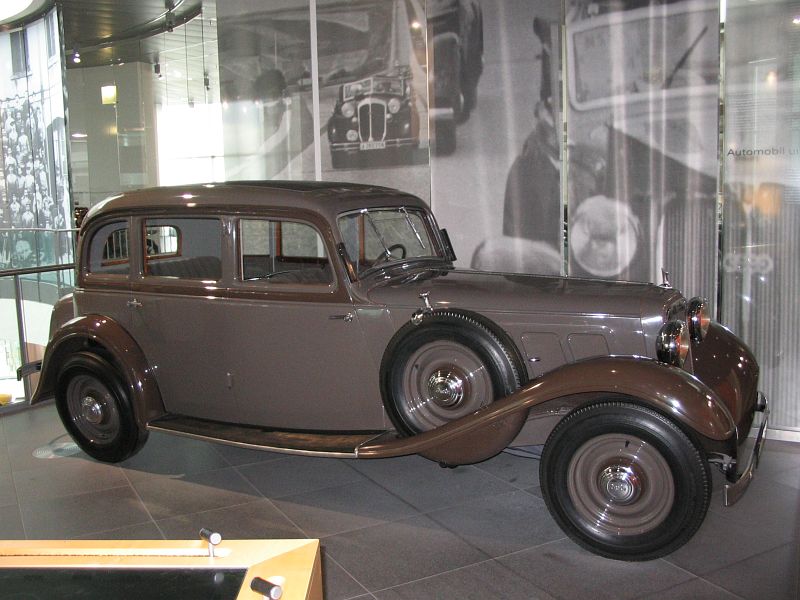The early 1930s marked a transformative period in automotive history. Amid economic uncertainty and technological advancement, Audi emerged as a pioneer of innovation. The 1934 Audi Front UW stands as a testament to this era of bold engineering and revolutionary design thinking.
The merger of four prestigious German automakers — Audi, DKW, Horch, and Wanderer — into Auto Union AG in 1932 set the stage for unprecedented collaboration and innovation. The Front UW, introduced just two years later, would become one of the first fruits of this historic union.
Engineering Marvel: The Reverse Wanderer
The Audi Front UW’s most striking feature lies beneath its elegant exterior. Engineers made the bold decision to position the transmission at the front of the vehicle, earning it the nickname “reverse Wanderer.” This unconventional arrangement, paired with front-wheel drive, represented a significant departure from contemporary design principles.
The heart of the Front UW beats with a 2.0-liter inline-six engine, delivering 40 horsepower through a four-speed manual transmission. While modest by today’s standards, this powerplant provided ample performance for the era’s road conditions.
“The Front UW’s drivetrain layout was revolutionary for its time. It challenged our understanding of weight distribution and handling dynamics. Even today, studying its design provides valuable insights into automotive engineering evolution.” — Dr. Marcus Steinfeld, Automotive Historian at the Technical University of Munich
This innovative powertrain configuration influenced automotive design for decades to come, setting precedents still visible in modern front-wheel-drive vehicles.
Jaray’s Aerodynamic Revolution
Historical Reference!
Paul Jaray patented his groundbreaking aerodynamic design principles in 1921, which would later revolutionize automotive styling through vehicles like the Audi Front UW.
The 1934 Audi Front UW Jaray edition showcased Paul Jaray’s revolutionary approach to aerodynamic design. Key features include:
- teardrop-shaped body profile maximizing air flow;
- rounded front fascia reducing drag coefficient;
- integrated fenders enhancing overall streamlining;
- sloped rear section minimizing turbulence;
- curved roofline optimizing air movement.
These design elements weren’t merely aesthetic choices — they represented a scientific approach to automotive aerodynamics.
“Jaray’s influence on the Front UW’s design was transformative. His understanding of aerodynamics predated wind tunnel testing, yet his principles remain relevant in modern automotive design.” — Claire Bennett, Automotive Design Curator, Munich Transport Museum
Legacy and Collector’s Pride
The Audi Front UW represents more than just technical innovation — it embodies a pivotal moment in automotive history. As one of the last pre-war Audi models, it bridges the gap between classical and modern automotive design.
Today, surviving examples command significant attention from collectors and historians alike. Their rarity and historical significance make them highly sought after, though finding one in original condition presents a considerable challenge.
Fact!
Only a handful of original Audi Front UW models survive today, with the Jaray-designed versions being particularly rare. The last public sale of a restored example occurred in 2019, fetching over €280,000 at auction.
Restoration experts note the unique challenges these vehicles present. The specialized front-drive system and aerodynamic body panels require extensive knowledge and craftsmanship to maintain or rebuild.
A Pioneer’s Tale: Looking Forward Through the Past
The Audi Front UW’s influence extends far beyond its brief production run. Its innovative drivetrain layout predicted the dominance of front-wheel-drive configurations in modern passenger cars. The aerodynamic principles championed by its design continue to influence automotive styling.
As we look to the future of automotive design, the Front UW reminds us that true innovation often means challenging established conventions. Its legacy lives on in every front-wheel-drive vehicle and every car shaped by aerodynamic principles.
Pros and Cons
| Advantages | Disadvantages |
|---|---|
| Revolutionary front-wheel-drive system providing improved traction | Limited production numbers making parts extremely rare |
| Advanced aerodynamic design reducing drag | Complex drivetrain layout challenging to maintain |
| Spacious interior thanks to efficient packaging | Lower power output compared to contemporary luxury vehicles |
| Historical significance enhancing collector value | High restoration costs due to specialized components |
| Innovative transmission placement influencing future designs | Scarcity of technical documentation for repairs |
The Audi Front UW stands as a remarkable testament to pre-war automotive innovation. While its limited production run and complex engineering present challenges for modern collectors, these same qualities make it an invaluable piece of automotive history. Its blend of revolutionary engineering and aerodynamic design continues to inspire automotive enthusiasts and engineers alike.

